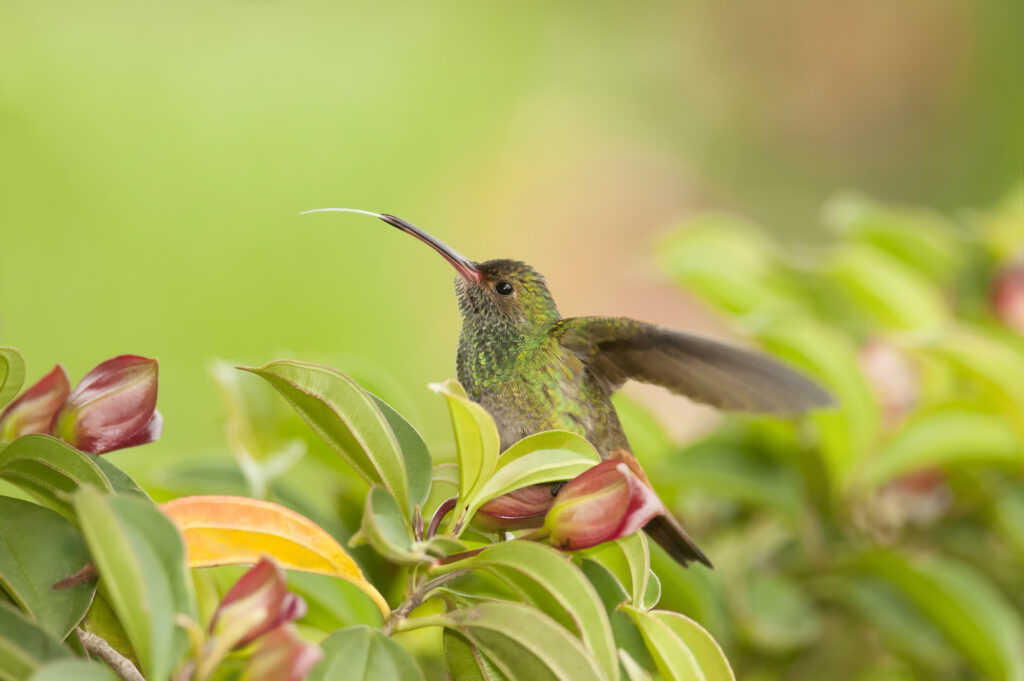Even though you rarely see it, hummingbirds can open their long bills.
Hummingbirds are most commonly seen by humans at tubular flowers and hummingbird feeders, where they use their needle-thin beaks to reach deep and find food.
In doing so, it may not seem like their beaks would need to open much, but you may be surprised at what a hummingbird reaching for nectar truly looks like up close.
This fascinating video from researchers at the University of Connecticut shows how hummingbirds open their beaks, making way for a long tongue to reach deep into feeders or deep flowers and secure nectar.
A hummingbird’s tongue is so long that when not in use, it actually spans the length of the entire beak and then wraps around the bird’s skull. They’re not the only birds with this feature; woodpeckers’ tongues also wrap around the brain to prevent damage when drilling into wood.
In conducting their study, UCONN researchers proved that hummingbirds use their tongues like pumps to drink nectar, debunking a long-held theory that hummingbird feeding was conducted through a process called “wicking” or the idea that hummingbird beaks are used as some sort of straw.
Hummingbird Tongues and Bills: Not Just for Nectar
And despite their reputation as nectar-eating birds, most of a hummingbird’s diet is actually bugs.
According to University of Delaware Entomologist Doug Tallamy, about 80 percent of a hummingbird’s food supply consists of insects and spiders (via Georgia Department of Natural Resources).
The Georgia DNR goes on to say that when they’re in the process of feeding their young, female hummingbirds may eat as many as 2,000 insects per day.

This requires hummingbirds to open their narrow beaks at least a little bit, which makes for interesting viewing, considering how rare a sight it is.
That hummingbirds eat so many insects should be a good inspiration for gardeners and backyard bird enthusiasts to create a yard full of native plants that allow for lots of life and provide birds with many food sources.
For more on hummingbird diets, click here.
About Hummingbird Beaks
Regardless of how far they can open them, hummingbirds have interesting beaks. Though they may measure just millimeters long, they’re quite long in relation to the birds’ tiny bodies. In fact, the sword-billed hummingbird, a native of South America, holds the title of the longest beak of any bird in relation to body size.
Next time you see a hummingbird in your garden, at a hummingbird feeder, or buzzing through wildflowers in search of nectar, pull out your telephoto camera lens, spotting scope, or binoculars and see if you can get a glimpse of the hummingbird’s unique beak.
While you may not be able to see it open and close, you might gain a greater appreciation for how hummingbirds collect their food.
More To Explore
Hummingbirds are some of the most captivating species of birds out there, from the tiny bee hummingbird to South America’s giant hummingbird, drawing attention from birdwatchers and gardeners alike. There are so many more interesting facts to learn about hummingbirds, from what types of flowers they prefer to when they arrive and leave an area each year.
Wild Bird Scoop is the go-to for the hummingbird fanatics out there, with the answers to all of your questions.
Frequently Asked Questions
How Wide Does a Hummingbird’s Beak Usually Open?
While hummingbirds can open their beaks quite wide, it’s rare to see them open much more than a few millimeters.
Much of their beak movement consists of just opening the beak far enough so its tongue can extend and pull in the nectar of a flower or feeder.
Is It Called a Bill or a Beak?
While some people may debate the topic with a bit more fervor, you can generally call it whichever one you like better.
Some will argue that beaks are sharper or pointier like those of songbirds or birds of prey and bills are meant for birds like ducks. But at the end of the day, whichever one you say, most people will know what you mean.
What Does a Hummingbird’s Beak Look Like?
The best way to describe the shape and length of a hummingbird’s beak is “needle-thin.” Most hummingbirds are only a couple of inches long and a couple of grams in weight, and their beaks, while fairly long proportionately, are very thin and short.
According to Operation Rubythroat, the average beak of a ruby-throated hummingbird measures between 15 and 21 millimeters long.
When they feed on nectar, their beak opens just slightly and a pointed, slender tongue emerges to secure their food.

